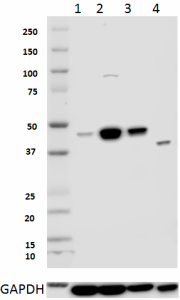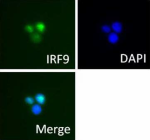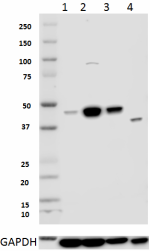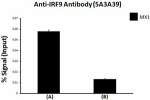- Clone
- 5A3A39 (See other available formats)
- Regulatory Status
- RUO
- Other Names
- Interferon regulatory factor 9 (IRF-9), Interferon-stimulated gene factor 3 gamma (ISGF-3 gamma), ISGF3 p48 subunit
- Isotype
- Mouse IgG2b, κ
- Ave. Rating
- Submit a Review
- Product Citations
- publications

-

Total lysates (15 µg protein) from Jurkat (lane 1), Jurkat treated with IFNα1 (lane 2), THP-1 (lane 3) and Raw264.7 cells (lane 4) were resolved by electrophoresis (4-20% Tris-Glycine gel), transferred to nitrocellulose, and probed with 1:1250 diluted (0.4 µg/mL) Purified anti-IRF9 Antibody, clone 5A3A39 (upper). Proteins were visualized by chemiluminescence detection using a 1:3000 diluted goat anti-mouse-IgG secondary antibody conjugated to HRP for the anti-IRF9 Antibody or a donkey anti-rabbit IgG Antibody conjugated to HRP for anti-GAPDH Antibody. (lower). Lane M: Molecular weight ladder. -

IFN-α treated Jurkat cells were stained with purified anti-IRF9 (5A3A39) antibody, followed by staining with DyLight™ 488 conjugated goat anti-mouse IgG (green) antibody (Cat. No. 405310). Nuclei were stained with DAPI (blue). -

Chromatin Immunoprecipitation (ChIP) was performed using commercial Protein-G coated 96 well high-throughput ChIP assay kit by loading 3 µg of cross-linked chromatin samples from THP-1 cells treated with IFNα2 with either A) 1:50 dilution of Go-ChIP-Grade™ Purified anti-IRF9 (Clone 5A3A39), or B) equal amount of Purified Mouse IgG2b, κ Isotype Control Antibody. The enriched DNA was purified and quantified by real-time qPCR using primers targeting human MX1 gene region. The amount of immunoprecipitated DNA in each sample is represented as signal relative to the 5% of total amount of input chromatin.
| Cat # | Size | Price | Quantity Check Availability | Save | ||
|---|---|---|---|---|---|---|
| 660702 | 100 µg | 231€ | ||||
IRF9 is a member of the IRF family of transcription factors and plays an important role in IFN signaling pathways and anti-viral immune responses. Type I and type III interferon stimulation induces phosphorylation and heterodimerization of STAT1 and STAT2. The activated STAT1:STAT2 heterodimer recruits IRF9 and forms a heterotrimeric complex termed IFN-stimulated gene factor 3 (ISGF3). The ISGF3 complex, in turn, translocates to the nucleus and transactivates IFN-inducible genes. The IRF9 protein in the ISGF3 complex is responsible for the recognition of IFN-stimulated response elements (ISRE). Mice lacking IRF9 fail to induce the expression of IFN regulated genes in response to type I interferon stimulation, indicating that IRF9 is crucial in mediating interferon signaling.
Product DetailsProduct Details
- Verified Reactivity
- Human
- Antibody Type
- Monoclonal
- Host Species
- Mouse
- Immunogen
- Partial human IRF9 recombinant protein (116-387 a.a.) expressed in E. coli.
- Formulation
- This antibody is provided in phosphate-buffered solution, pH 7.2, containing 0.09% sodium azide.
- Preparation
- Affinity purified.
- Concentration
- 0.5 mg/mL
- Storage & Handling
- Upon receipt, store undiluted 2°C and 8°C.
- Application
-
WB - Quality tested
ICC, ChIP - Verified - Recommended Usage
-
Each lot of this antibody is quality control tested by Western blotting. For Western blotting, the suggested use of this reagent is 0.4 - 2.5 µg per mL. For ChIP applications, the suggested dilution is 1:50 to 1:200 by volume. It is recommended that the reagent be titrated for optimal performance for each application.
- Application Notes
-
This clone does not react with mouse (in-house tested). A non-specific band was observed (around 37 KD) when this antibody was tested on Raw264.7 cells
- Product Citations
-
- RRID
-
AB_2563575 (BioLegend Cat. No. 660702)
Antigen Details
- Structure
- 393 amino acids, predicted molecular weight of 44 kD; contains a IRF tryptophan pentad repeat responsible for DNA binding.
- Distribution
-
Cytoplasm, phosphorylated form translocated to the nucleus.
- Function
- IRF9 is a transcription factor that mediates interferon signaling and activates the expression of interferon inducible genes.
- Interaction
- Forms the interferon-stimulated gene factor 3 complex (ISGF3) with Signal Transducer and Activator of Transcription 1 (STAT1) and STAT2 in response to type I IFN stimulation.
- Biology Area
- Cell Biology, Immunology, Innate Immunity, Signal Transduction, Transcription Factors
- Molecular Family
- Nuclear Markers
- Antigen References
-
1. Fink K and Grandvaux N, 2013. JAKSTAT. 2:e27521.
2. Tsuno T, et al. 2009. J. Immunother. 32:803.
3. Thibault DL, et al. 2008. J. Clin. Invest. 118:1417.
4. Kraus TA, et al. 2003. J. Biol. Chem. 278:13033.
5. Xiao W, et al. 2001. J. Biol. Chem. 276:23275.
6. Veals SA, et al. 1992. Mol. Cell. Biol. 12:3315. - Gene ID
- 10379 View all products for this Gene ID
- UniProt
- View information about IRF9 on UniProt.org
Other Formats
View All IRF9 Reagents Request Custom Conjugation| Description | Clone | Applications |
|---|---|---|
| Purified anti-IRF9 | 5A3A39 | WB,ICC,ChIP |
Compare Data Across All Formats
This data display is provided for general comparisons between formats.
Your actual data may vary due to variations in samples, target cells, instruments and their settings, staining conditions, and other factors.
If you need assistance with selecting the best format contact our expert technical support team.

 Login / Register
Login / Register 










Follow Us